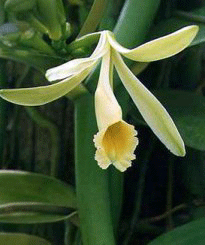March 24, 2007 Article
by
David Rodriguez
 Vanilla is the only edible fruit of the orchid family, the largest family of flowering plants in the world. It’s a tropical orchid, and there are about 150 varieties of vanilla, though only two types – Bourbon and Tahitian — are used commercially.
Vanilla is the only edible fruit of the orchid family, the largest family of flowering plants in the world. It’s a tropical orchid, and there are about 150 varieties of vanilla, though only two types – Bourbon and Tahitian — are used commercially.
Vanilla grows within the 20-degree band either side of the Equator and is native to the Americas.
Vanilla planifolia (also known as fragrans) grows on the Atlantic Gulf side of Mexico from Tampico around to the northeast tip of South America, and from Colima, Mexico to Ecuador on the Pacific side. It also grows throughout the Caribbean.
The Totonaca people of the Gulf coast of Mexico were probably the first people to cultivate vanilla. They taught many other indigenous people how to grow vanilla during MesoAmerican times, and they continue to cultivate the fruit that they consider was given to them by the gods.
Vanilla first left Mexico in the early 1500s on ships bound for Spain. It was originally believed only to have value as a perfume. It was not until Cortes arrived in 1519 that the Spaniards learned it was also a flavor.
Until the late 19th century, Mexico had the monopoly on growing vanilla, but now Madagascar and Indonesia grow the majority of the world’s crop. Additional countries that grow vanilla include Guatemala, Costa Rica, Uganda, China, India, Papua New Guinea, Tonga, Fiji, Tahiti, and the Philippines.
Vanilla is the world’s most labor-intensive agricultural crop, which is why it’s so expensive. It will take up to three years after the vines are planted before the first flowers appear. The fruits, which resemble big green beans, must remain on the vine for nine months in order to completely develop their signature aroma. However, when the beans are harvested, they have neither flavor nor fragrance. They develop these distinctive properties during the curing process.
When the beans are harvested, they are treated with hot water or heat and are then placed in the sun every day for weeks-to-months until they have shrunk to 20% of their original size. After this process is complete, the beans are sorted for size and quality. Then they will rest for a month or two to finish developing their full flavor and fragrance. By the time they are shipped around the world, their aroma is quite remarkable!
Because vanilla has always been so valuable, it has a long history of robbery and intrigue. In Madagascar, vanilla rustling was a major problem for many years. Growers branded the individual beans when they were green and the markings remained after they were dried.
Whenever someone suspected their beans were stolen, they could determine by their distinctive tattoo whether or not the beans were theirs.
Bourbon vanilla is named for the islands now known as Reunion and the Comoros, but in the early 19th century, they were called the Bourbon Islands. The Bourbon vanilla plant stock originally came from Mexico. Bourbon vanilla and Mexican vanilla are basically the same.
Tahitian vanilla also originally comes from Mexican plant stock, but it mutated at some point in the last fifty to sixty years and became its own species. It is significantly different from Bourbon and Mexican vanilla.
The United States is the world’s largest consumer of vanilla, followed by Europe – especially France. About 1400 tons of dried vanilla is produced worldwide each year. Our worldwide interest in natural vanilla has grown considerably in the past several years, however, and the current annual demand is for 2200 tons of vanilla.
Vanilla is not only used as a flavor in foods and beverages, but also in perfumes. It’s also used in many industrial applications such as a flavoring for medicines and as a fragrance to conceal the strong smell of rubber tires, paint, and cleaning products.
The dairy industry uses a large percentage of the world’s vanilla in ice creams, yogurt (fresh and frozen), and other flavored dairy products. Despite all the wonderful ice cream choices available in the market place, most customers say, “Make mine vanilla!”
Because vanilla is so much in demand and is so expensive, synthetics are often used instead of natural vanilla. In fact, 97% of vanilla used as a flavor and fragrance is synthetic.
(Source: www.vanilla.com)
David Rodriguez is the County Extension Agent-Horticulture, Bexar County. For more information, call the Master Gardener ‘Hotline’ at (210) 467-6575 or visit our County Extension website at http://bexar-tx.tamu.edu, click under Horticulture and Gardening.